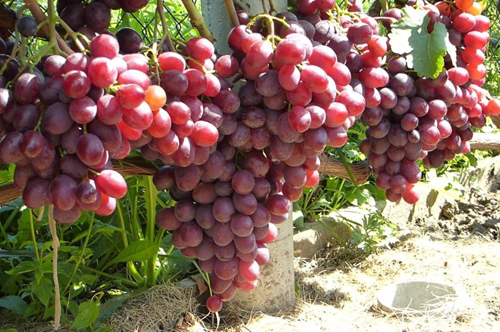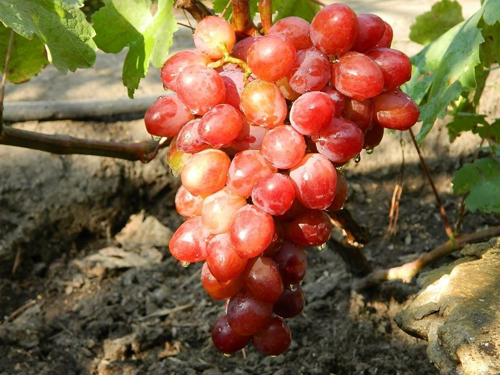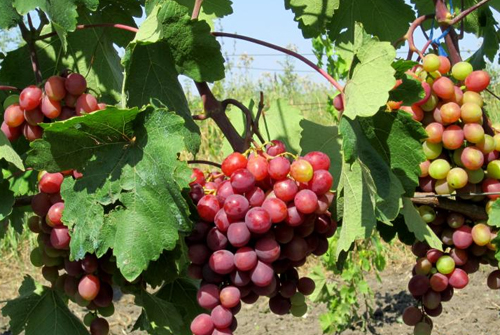Grape variety in memory of the teacher
In memory of the Teacher - an amateur table grape variety, the fruit of the labor of Evgeny Pavlovsky from Novoshakhtinsk, Rostov region. The novelty is dedicated to a person who at one time became a guide and mentor for a folk breeder in a research area that was completely far from the original direction of his interests and activities. This teacher is a legendary personality - an outstanding scientist winegrower, Honored Agronomist of the Russian Federation, laureate of the RF Government Prize Ivan Aleksandrovich Kostrikin. It was on his advice that Pavlovsky in the 90s of the last century took up a completely new business for himself - hybridization and the selection of new promising forms of grapes. For many years he was engaged in this work under the methodological guidance of Kostrikin, who taught him many subtleties of breeding work, and this tandem turned out to be very productive.

The result of this joint activity has become a multitude of various hybrid forms that are loved by thousands of amateur winegrowers, both domestic and from neighboring countries. Moreover, a certain part of the novelties was transferred to the state variety testing, some successfully passed it, and were included in the State Register of Breeding Achievements Permitted for Use. One of the officially recognized works of Pavlovsky is the Memory of the Teacher, on the development of which the national breeder and his mentor worked together, and he received its name after the death of Ivan Alexandrovich in 2009. Today the variety is approved for horticultural use throughout the territory of the Russian Federation. The completion of the state test and inclusion in the State Register took place in 2016.
Famous varieties served as parental forms for the new grapes - domestic Mascot and American Cardinal... From the first, high economic qualities and large-fruited were inherited, and from the second, excellent gastronomic characteristics and early ripening of the crop. At Pavlovsky, this couple gave birth to several hybrid forms at once, being as beloved as the Talisman with Radiant kishmish Viktor Krainov or Talisman with Rizamatom from Vasily Kapelyushny. The presence in all variants of the Talisman is explained by its high genetic potential and, most importantly, by the functionally female type of flower, which allows amateur breeders to work with it.
But, despite the amateur origin, the Memory of the Teacher has remarkable properties that predetermine the high interest in it on the part of winegrowers, who widely cultivate it both for themselves and for commercial purposes. In 2015, the variety received the Audience Award at the Solar Bunch festival-competition.

Agrobiological characteristics
Plants show high vigor. The crown of a young shoot is light green, with a white tint from tomentose pubescence of medium intensity, bordered by a reddish strip along the edge of the blossoming leaves. Young leaves of grapes are colored greenish-red. A fully formed leaf is large, wavy, elongated, has five lobes with a strong degree of dissection. The upper side of the leaf blade is green with anthocyanin veins, reticulate-wrinkled, the back is covered with weak cobweb pubescence. The upper lateral notches are deep, open, with parallel sides and a rounded bottom, or slit-like; the lower ones are much shallower in depth, V-shaped, or barely outlined. The petiole notch is open, vaulted, with a sharp bottom. The petiole is above medium length, green with a transition to red-violet. The teeth along the edge of the leaf are unequal in size, triangular and transitional to dome-shaped.The flowers of the variety are bisexual, well pollinated without additional pollinators, they are not inclined to open peas, but in some seasons there is a certain variety of berries. The shoots of the Teacher's Memory ripen almost along the entire length, despite their very significant growth. When ripe, they acquire a light brown color.
The bunches of grapes are very large in size and mass. The average weight of the collected brush is 800-900 grams, but there are specimens that are much larger. The shape of the bunches is cylindro-conical, the density is moderate, which protects the berries from deformation and damage to each other. The comb is strong, branched, colored by analogy with the leaf petiole. The berries are oval or obovate, very large, weighing 10-14 grams, purple or dark red, covered with an intense gray waxy bloom. The flesh of the variety is dense, fleshy and slightly crunchy, with a magnificent refined taste with tones of nutmeg in the aroma and aftertaste. The color of the freshly squeezed juice is pink, its sugar content is 18.2 grams / 100 ml, the titratable acidity is 5.1 grams / liter. The skin is medium in thickness, quite firm, but edible. There are very few seeds in the berry - 1-2, and their size is very moderate, which has a positive effect on the gastronomic characteristics. The average tasting score in the Memory of the Teacher, shown in the framework of the state variety testing, is 8.95 points.

Table grapes, great for fresh consumption, but also looks quite worthy as a raw material for home canning. This variety is used to prepare wonderful jams, preserves and compotes with an elegant color and excellent taste and aroma. On the market, grapes enjoy the well-deserved attention of buyers, due to their large fruit size and visual appeal. The early onset of removable ripeness allows you to sell the crop at relatively high prices, which plays an important role in the profitability of the farm. The possibilities for implementation are significantly expanded due to the good ability of the Memory of the Teacher to transfer movement over long distances, as well as the good ability of the bunches to be stored without losing taste and marketability. The storage period under optimal conditions can be up to three months.
The variety is early maturing. The growing season lasts an average of 100-105 days, counting from the beginning of bud break, up to the readiness of the bunches for harvesting. During this time and heat, it requires relatively little - only 2100-2200 ° C of the sum of active temperatures. In the south, harvesting begins in the third decade of July - early August, but as you move to the north, the dates are shifted to September and even later. This variety of grapes shows the ability to ripen even in Belarus and the Moscow region, not to mention the more warm regions. Thanks to this, it became widespread among amateur winegrowers, and the process of popularization continues to gain momentum.
In memory of the teacher, he demonstrates tremendous productivity. The average yield per hectare of plantations is almost 200 centners, or about 10 kilograms per bush. At the same time, the best plants show a significantly greater result, which indicates the highest potential of the variety itself. At the same time, such generosity is not always supported by the physiological capabilities of the grape bush, which can cause its overload. The task of an experienced grower is to prevent this, constantly maintaining a balance between the strength and vitality of a particular plant and the load of its harvest.
Ripe bunches can remain hanging on the vine for a significant period of time without negative consequences. On the contrary, this will make them even sweeter, and the characteristic nutmeg aroma will only intensify. The berries do not have a significant predisposition to cracking and subsequent rotting, only in the most unfavorable seasons a similar defect can appear in the Memory of the Teacher. The dense skin should protect the grapes well from wasp damage, but some growers still complain about insect problems.The same reports are found on the facts of bird raids on the vineyard. This should be taken into account and possible damage should be prevented, especially in the case of late harvesting of the grapes.
Agrotechnical features
In memory of the Teacher, he belongs to those representatives of amateur selection who, in addition to aesthetic and gastronomic, also have good economic qualities. The variety, of course, cannot be called a champion in stability and unpretentiousness, but the term "capricious" is definitely not about it.
It has the same requirements for soils as for any other grape. It does not tolerate excessive dryness and dampness of the soil, planting in the lowlands of valleys and gullies and on the northern slopes, where it will not have enough heat, and the likelihood of frost damage will significantly increase. The level of fertility is not a limiting factor, because it can always be corrected by feeding plants with mineral and organic fertilizers. Despite the rather modest requirements of the variety to the amount of heat, in the northern regions of cultivation, measures to increase the level of SAT will not interfere with it. The main one is planting grapes under protection from cold winds, which can serve as walls of various buildings, dense fences, hedges, etc. The bushes are placed on their southern side.
At the moment, there is no data on the resistance of the Teacher's Memory to the root phylloxera, which means that planting in the zones of infection with it should take place with seedlings grafted onto phylloxera-resistant rootstocks. Own-rooted culture is possible only where there is confidence in the absence of a malicious soil pest. With vertical placement of one-year growth, the distance between rows should be 2.25-2.5 m, and between bushes in a row - 1.75 m. Thus, the feeding area will be about 4-5 square meters. The high vigor of plant growth significantly reduces the need for planting material per unit area.
The frost resistance of the variety still remains unconfirmed, and although the originator declared a fairly good indicator at -23 ° C, most winegrowers still cover the vines, even where they, it would seem, should winter confidently without this procedure. This approach seems to be irrational, primarily in the south, in traditional wine-growing regions. Here you can advise the use of a semi-covering formation, which assumes that the grape bushes have two parts - the main one, located on an uncovered trunk, and the reserve one, presented in the form of a lightweight lower tier, warmed for the winter. This approach will allow you to check for certain the ability of the variety to grow in your climate without the time-consuming procedure of covering the entire plant. The reserve vine will serve as a reliable guarantee of the preservation of the viability and quick recovery of the bush in case of a failure of the experiment. Typical covering forms, like a fan-shaped multi-arm or inclined cordon, should be used in frost-prone regions where the declared resistance of the teacher's memory to the winter cold is obviously insufficient. At the same time, various materials can be used as a shelter. In less cold areas, it is enough to simply bury the aboveground part in the ground, while in more severe conditions, special insulation will be required - straw, spruce branches, shavings, reeds, followed by waterproofing of the insulating layer with roofing material, film or wooden shields to prevent melt water from getting wet.
Spring pruning of bushes is used medium - 6-8 eyes. The total load for the Teacher's Memory is standard for grape varieties with sufficient shoot fruitfulness - 30-40 buds per adult plant. During the growing season, a fragment of sterile and weak shoots is carried out, as a result of which about 20-24 productive ones remain.Extra bunches are also removed on them, keeping one per shoot. This approach guarantees both a high yield and protection of the bushes from overloading. From green operations, it is also imperative to remove stepchildren, whose active growth can lead to thickening of the crown. At the end of the growing season, minting for better maturation of one-year growth will not hurt.
With regard to the most common fungal diseases - mildew and oidium, the variety shows an average degree of resistance - 3-3.5 points. This indicator is significantly better than that of the susceptible European varieties, including the father's Cardinal, but, nevertheless, weaker than the complex-resistant forms of grapes, which practically do not need chemical protection. In this regard, the Memory of the Teacher needs 2-3 sprays against harmful pathogens at the beginning of the season, and subsequent treatments only in case of signs of the disease. This approach can significantly save chemical plant protection products and reduce pesticide load, but at the same time requires a certain level of literacy from the grower in this area. In addition, grapes need protection of berries from wasps, which in large areas can be realized with the help of special traps, and in a backyard culture it will not be difficult to place each bunch in a special bag, where it will be safe from annoying insects.
In general, by the totality of all properties and economically valuable traits, the variety can be recognized as a very successful selection achievement and a worthy perpetuation of the memory of an outstanding scientist.








